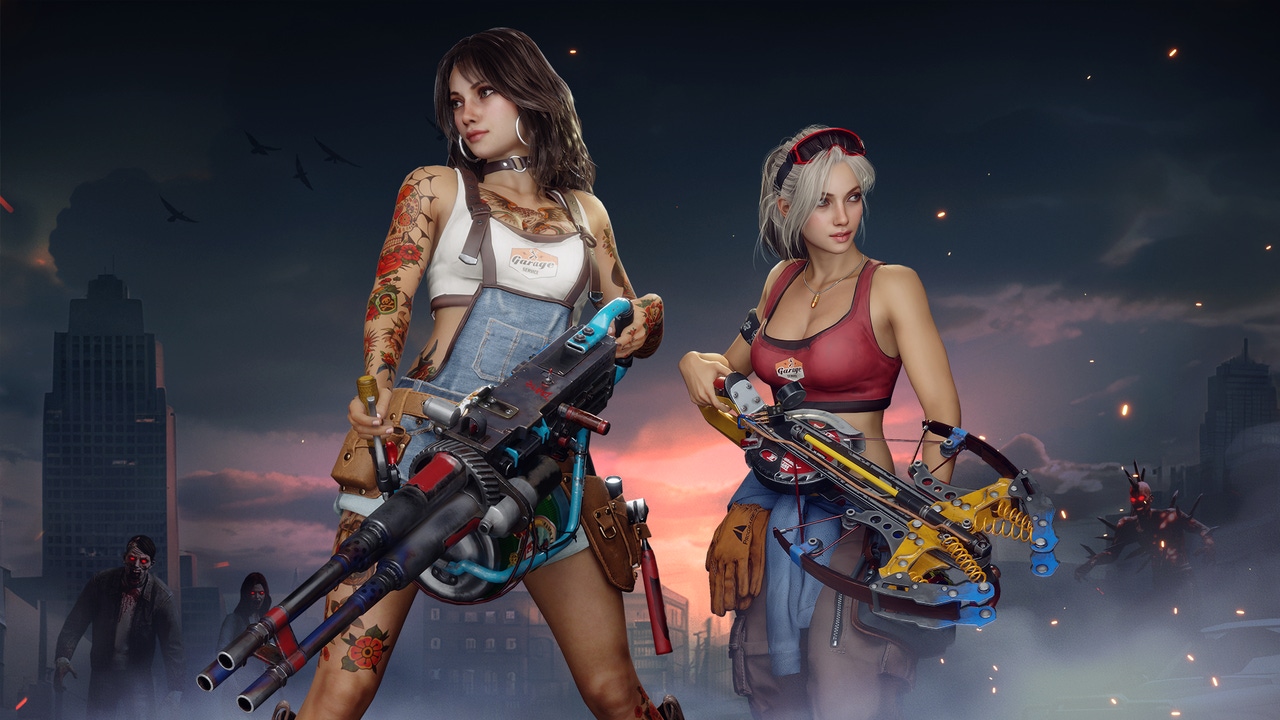
We’re the team behind weapon design for the mobile roguelike shooter Zombie State! As weapons are an integral part of the zombie elimination process, in this post, we’d like to share the creative and practical insights from our gun creation journey – from initial concept to final implementation in the game.
Here’s what we’ll cover:
Modeling and idea exploration
Animating shooting and reloading
Enhancing the shooting experience and player immersion
Here’s the list of people, who contributed to writing this article: Art Director Denis Pozdnyakov, Lead 3D Artist Valentin Penkov, Head of Animation department Vilsur Bulgakov, Game Designer Yaroslav Ivkin.
Where it all began
In game development, challenges often arise: concepts change, new features are introduced, and previous work may need to be redone. Zombie State was no exception. This is because midway through development, the team decided to overhaul the meta and gameplay.
While this risky decision ultimately proved beneficial, it’s worth noting that it required us to make significant changes under tight deadlines. The art team faced an ambitious task: to design and configure 15 entirely new guns in a short timeframe.
In terms of process, while game design handled configuration and balance, the art team focused on the behavior and visuals of the weapons; we received preliminary guidelines for the guns and were granted creative freedom in defining their appearance.
Weapon design is crucial in any shooter, as it directly affects player engagement, and our primary goal was to foster emotional attachment to each gun. Therefore, alongside the art team, we agreed that every weapon should have a unique character and a visually identifiable backstory.
We wanted players to envision the narrative behind each gun simply by looking at it. Of course, instead of relying on words to convey these stories, we set out to tell them artistically.
Notes on modeling new guns for Zombie State
When creating weapons for Zombie State, we were lucky enough to enjoy maximum creative freedom – and, since our goal was to ensure that the weapons looked visually engaging, we drew inspiration from existing firearms while reimagining them in a post-apocalyptic style.
In line with our creative freedom, this involved adding distinctive, non-original components to give the guns a handmade, garage-crafted feel.
Another note: for Zombie State, we typically bypassed the creation of 2D concepts and began directly blocking out designs in 3D. This approach proved more efficient and visually informative, allowing us to place a "blank" version of the weapon in the viewport. This approach also allowed us to better understand how players would perceive it and identify areas that required further refinement. Due to time constraints, we opted for a more dynamic form of conceptualization.
In moments of creative challenge, it was particularly helpful to visualize how a weapon functions mechanically: how to hold it, reload it, and how various components operate and move. Each gun carries with it a rich backstory, detailing our thought process, the development of different ideas, and the meticulous addition of fine details.
Our creative process in action
In the next sections, we’ll showcase several examples of our creative process.
Ocelot Revolver: from initial idea to final production

Here, we set out to create a rapid-fire weapon that delivers quick and powerful shots, despite having a small magazine size; these parameters guided our initial design. While we could have opted for a classic automatic pistol like a Beretta or Glock, we chose to go a different direction.
In our brainstorming sessions, we drew inspiration from Western films featuring Clint Eastwood. This immediately shaped our vision for the revolver's functionality, appearance, and animations. We designed the grip to be unconventional: instead of a classic hold, we opted for a hip grip with the supporting hand atop the trigger for quicker shooting.
The revolver also featured a unique reloading system: the bolt carrier lever had to be pushed down to access the cylinder. This design added an unusual, rugged aesthetic that enhanced the overall character of the weapon.

In this iteration, the reload animation took much longer than intended, resulting in the revolver feeling sluggish and counter to our initial vision. Displeased with this, we decided to completely redesign the weapon.
We conceived the idea of creating a museum-quality exhibit, as though the hero had retrieved it from an actual museum. Given this context, the gun needed to reflect that aesthetic: it should appear pristine, free from dirt or modifications, and possess intrinsic beauty.
We crafted an antique design featuring an ivory handle adorned with intricate patterns, as if it were a bespoke piece tailored for a heroic figure from a bygone era.
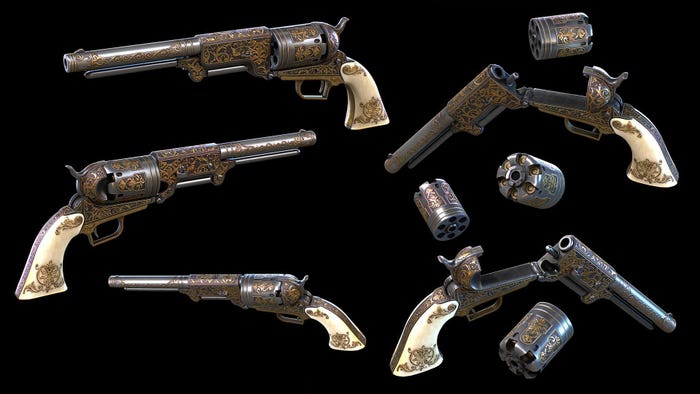
The weapon is fully visible from all angles, with no hidden polygons in the game model – the same model is utilized for gameplay, UI renders, and marketing.
The weapon is fully visible from all angles, with no hidden polygons in the game model – the same model is utilized for gameplay, UI renders, and marketing.
The Lucky Rabbit's Foot
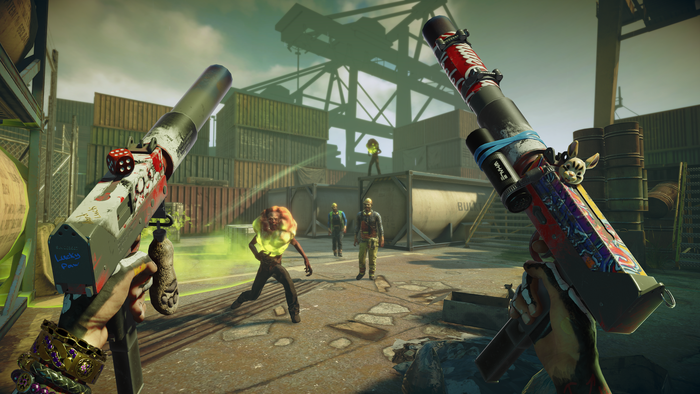
We determined there should be two submachine guns, as they embody classic gangster imagery.
However, we also aimed for each gun to have its own distinct personality. This led to the addition of a keychain shaped like a rabbit’s foot on one of the guns, setting the thematic tone for the weapon.
Subsequently, we incorporated other elements, such as dice, a rabbit head keychain, and graffiti paint, to further enhance its individuality.
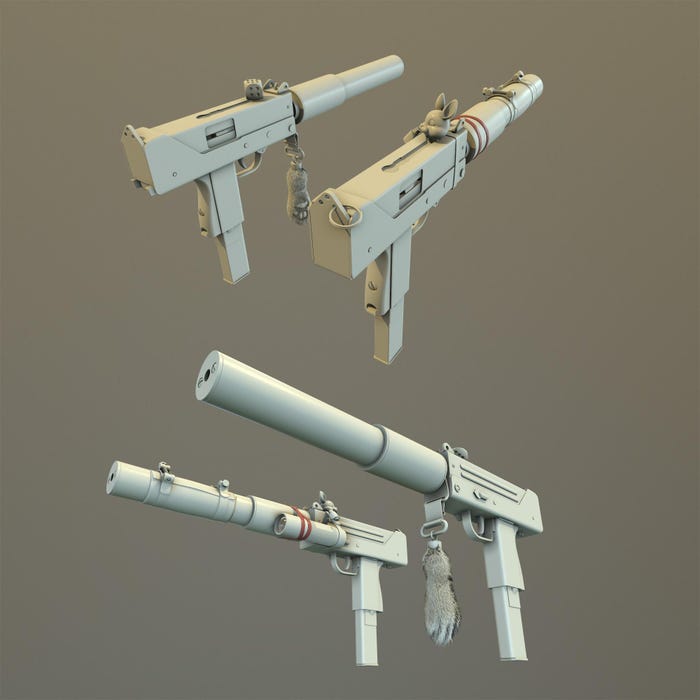

The animators incorporated dynamic dice for keychains and similar features, which brought a lively touch to the weapon.
The animators incorporated dynamic dice for keychains and similar features, which brought a lively touch to the weapon.
Meanwhile, a burnt-out muffler was transformed into a handcrafted element, secured with a few clamps and a soda can.
Although both submachine guns share a similar base, we successfully created unique personalities for each with minimal resources.
Saw Thrower: crafted in the garage
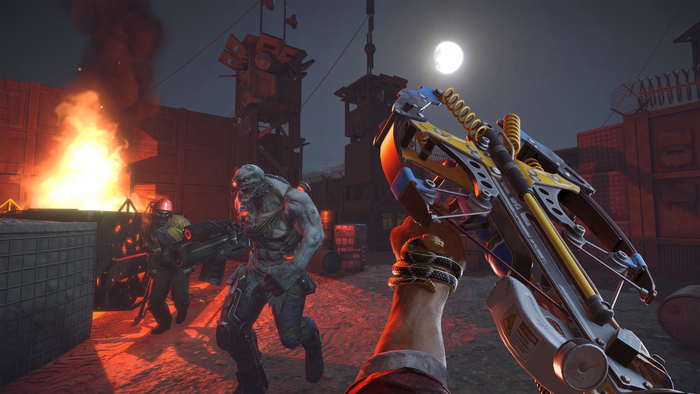
We needed a weapon with a wide horizontal hit zone, so we opted for a circular saw thrower. To emphasize its handmade nature, we designed the weapon as a DIY crossbow, assembled from chainsaw parts and other garage finds.
While the crossbow design logically suited the throwing of discs, it had a major drawback: a lengthy reload after each shot, which was impractical for gameplay. To address this, we implemented an electric/pneumatic reloading system – after firing, a pneumatic actuator pulls the bowstring back, while a sliding pin catches the disc. To enhance the visual complexity, we also added an electric relay and a pressure gauge.

Since the weapon consists of parts from tools, the question of "how to paint" it, in general, was not a problem. We bake all this in Marmoset Toolbag, and texture in Adobe Substance Painter
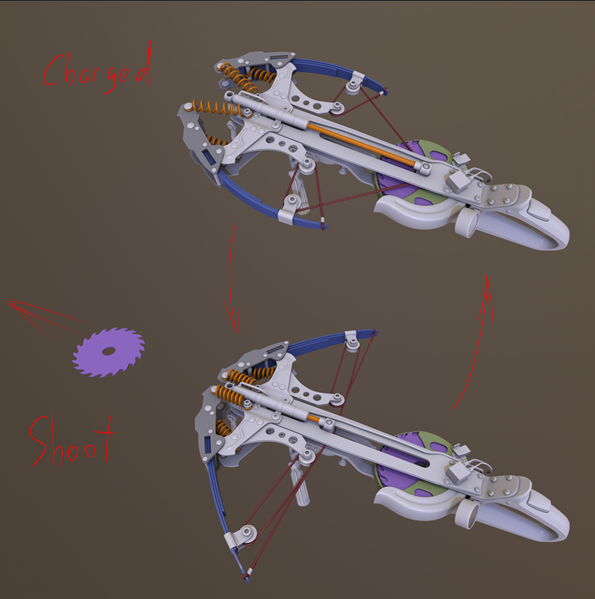
To make the work of animators easier, we sometimes create these sorts of diagrams – this allows us to more clearly show the operation of the mechanisms
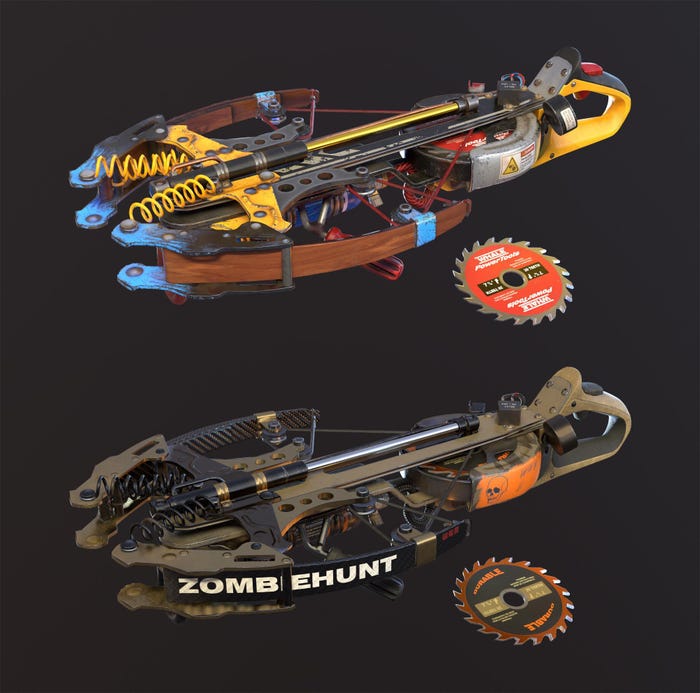
The minigun: heavy is good, heavy is reliable
When designing the minigun, our goal was to ensure it stood apart from the standard models while also reflecting a homemade aesthetic. The base of the weapon is a classic, large-caliber machine gun – but its defining feature is the rotating barrels, setting it apart from other machine guns.
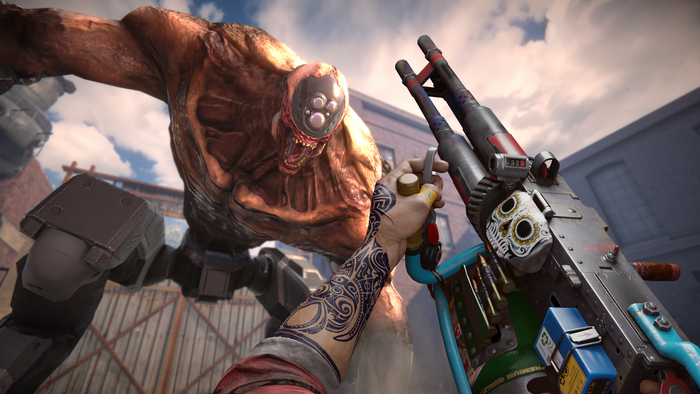
Again, we aimed to blend functionality with an intriguing DIY appearance. To achieve this, we connected several barrels via a common gear mechanism, using a modified car starter as the rotation motor, all powered by a battery with a quick-release mount.
But this was only part of the challenge!
We also needed to determine how the hero would hold and reload the weapon. After considering various options, we decided to construct a frame using pipes from an old bicycle. Additionally, since our design allowed for adjustable firing speed, we incorporated a bicycle gear shifter.
As a finishing touch, we repurposed a vintage bicycle odometer into an ammunition counter, adding an extra layer of detail to the weapon.

A small beer keg, secured with a car seat belt mount, served as an effective magazine. We also incorporated clamps, electrical tape, duct tape, wires, and switches throughout the design to enhance the "garage" aesthetic.
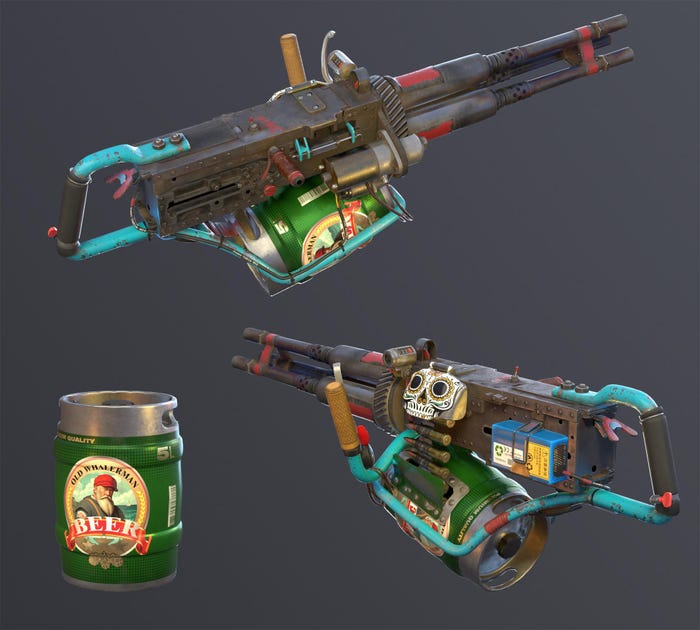
The imposing weight of the machine gun presented a challenge for handling, prompting us to position the grip on top for enhanced hip-fire capability and better balance.
However, this design posed a dilemma of its own: either the player’s view would obstruct the machine gun or their left hand would cover significant portions of the screen. Thankfully, by immediately creating a 3D concept block of the weapon, we identified this issue early in the development process, allowing us to streamline our iterations and avoid wasted effort.
The fireworks rocket launcher: holidays are coming
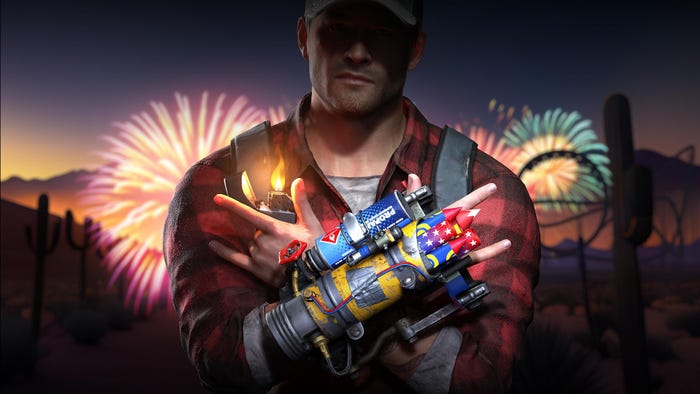
The firework rocket launcher was one of the most challenging guns for us in terms of concept, as it required us to create something completely out of the ordinary.
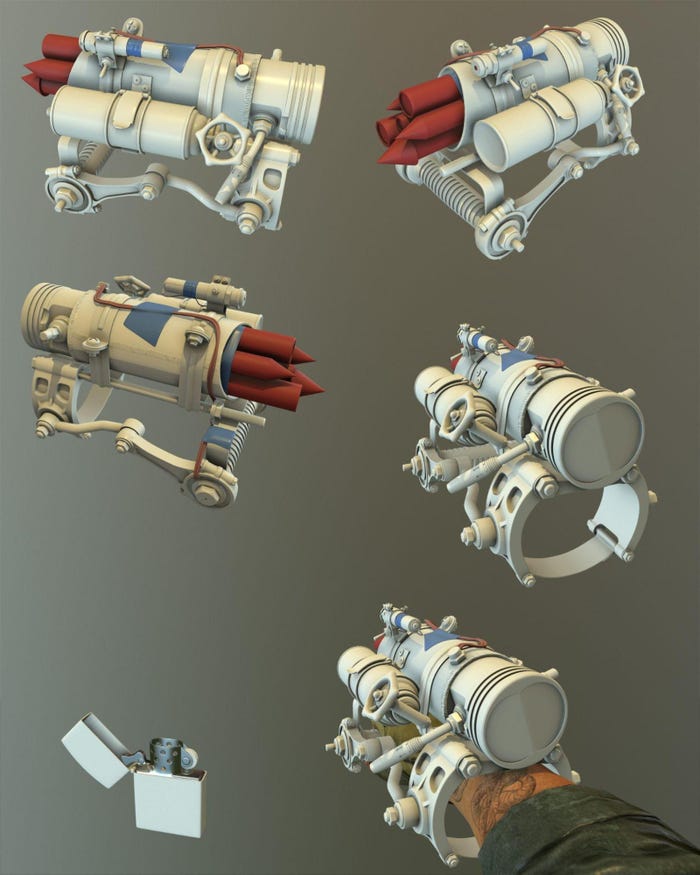
During our search, we came up with different versions of the flare gun: based on leather work gloves, tourist equipment, and a rocket made from gas cylinders. In the end, we decided that the weapon would look like a kind of hand-held construction assembled from "garage" parts:





































